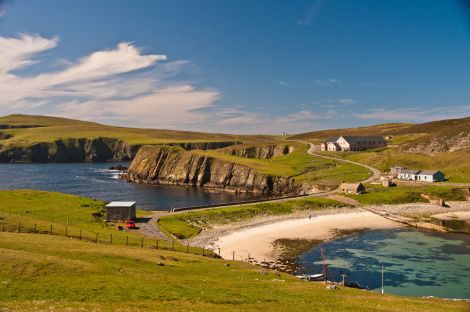News / Fair Isle calls for protected status
THE PEOPLE of Fair Isle are calling on the Scottish government to create a Marine Protected Area (MPA) in its waters to safeguard the future of one of Scotland’s most remote communities.
The call comes as a “Who’s Who” of ornithology travels to the tiny island to celebrate the official opening of its new bird observatory on Saturday.
The new £4 million building has been open since June last year, but it has taken until now to sort out difficulties created after main contractor Orkney-based Andrew H Wilson went into receivership.
The warden accommodation and its outbuilding had to be completed by John Best and Brian Wilson of local company Northmen (Fair Isle) Ltd.
Meanwhile the Fair Isle Bird Observatory Trust (FIBOT) negotiated with the local community to overcome bad feelings amongst local businesses that lost money after the main contractor went bust.
FIBOT director Louise Batchelor said they had been unable to compensate individual businesses, but had agreed to pay an undisclosed sum as a “disturbance allowance” into the island’s community association fund.
“This is in recognition of the inconvenience caused by the construction of the observatory. We paid a generous sum and I believe islanders were very happy with that,” she said.
Fair Isle community association chairwoman Fiona Mitchell said on Thursday that the islanders were concentrating on the future and had put the past behind them.
“The observatory work not only draws attention to our rich environment but also plays a large part in the socio-economic well-being and stability of the community by attracting visitors to Fair Isle and to Shetland,” she said.
She added that the entire community, including the bird observatory and the National Trust for Scotland who own the island, were behind the call to make Fair Isle’s coastal waters a demonstration and research MPA.
Become a member of Shetland News
Islanders have been concerned about breeding failure of some seabird species over recent years, and have repeatedly lobbied for better protection of the marine environment.
The new bird observatory replaces the first building, built in the 1960s, and laid the foundation for Fair Isle’s fame as a birders’ paradise.
Among the ornithological heavyweights attending Saturday’s opening are Ian Newton, an expert on bird migration, David Parkin, co-author of the definitive Status of Birds in Britain and Ireland (2010), David Jardine, president of the Scottish Ornithologists’ Club and Andy Clements, director of the British Trust for Ornithology.
The building will be officially opened by former warden and one of Scotland’s best known conservationists, FIBOT honorary president Roy Dennis.
Current trust chairman Roger Riddington said: “Our aim is to continue the research work on our seabirds, migrants and breeding land birds but in a setting where we can provide a welcoming environment for all visitors to Fair Isle.”
Former visitors will find big changes. The new observatory is eco-friendly with a high tech energy system that features innovative ‘breathing building’ insulation and heat recovery.
This means that any waste heat from, for example, the kitchen or laundry room, is captured and used to heat the accommodation, while filters in the walls deliver fresh air and keep heat loss to a minimum. There are also photovoltaic cells panels on the roof, which turn sunlight into electricity.
New warden David Parnaby said: “As a birder, working on Fair Isle is just as amazing as I thought it was going to be, there are times when I have to remind myself that this really is what I am paid to do.
“We’re in the middle of the breeding season and the island looks fantastic and full of life. The migrant birds have also been incredible, with an array of rarer species seen.
“It’s not just the birds that make the job special though, the range of people who have visited are what contribute to the atmosphere of the observatory. We’ve had loads of positive comments about the new building and plenty of people are already planning their next visit.”
The new building, on the site of the old, was made possible by many individual donations and money from charitable trusts as well as major funding from the Scottish government (£1,807,175); Shetland Islands Council (£1,090,766) and Highlands and Islands Enterprise (£359, 999).
Become a member of Shetland News
Shetland News is asking its many readers to consider paying for membership to get additional features and services: -
- Remove non-local ads;
- Bookmark posts to read later;
- Exclusive curated weekly newsletter;
- Hide membership messages;
- Comments open for discussion.
If you appreciate what we do and feel strongly about impartial local journalism, then please become a member of Shetland News by either making a single payment, or setting up a monthly, quarterly or yearly subscription.




























































